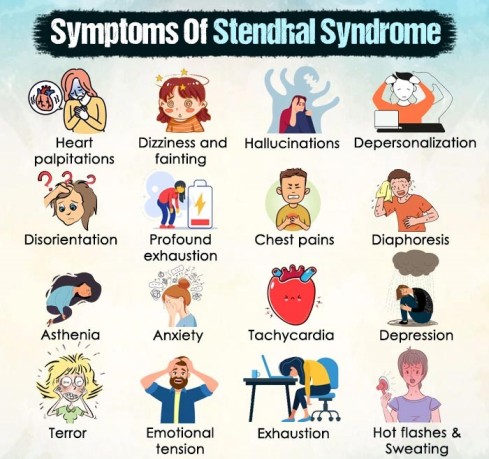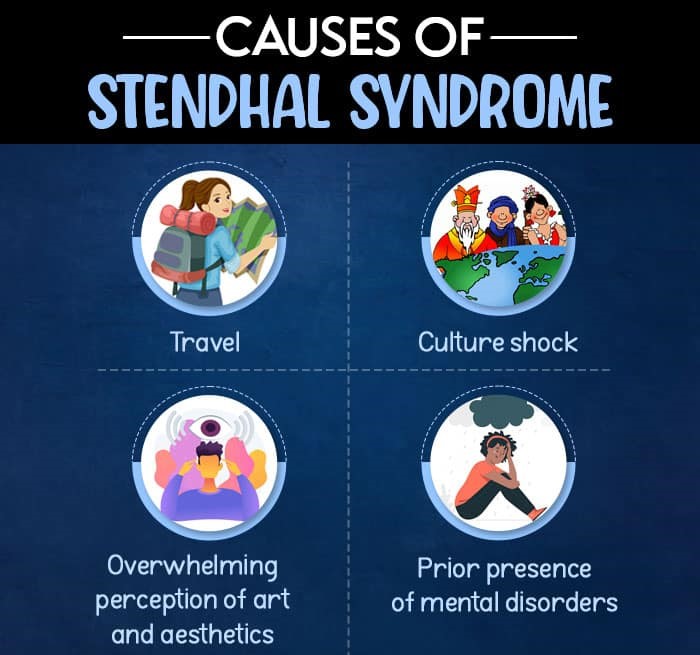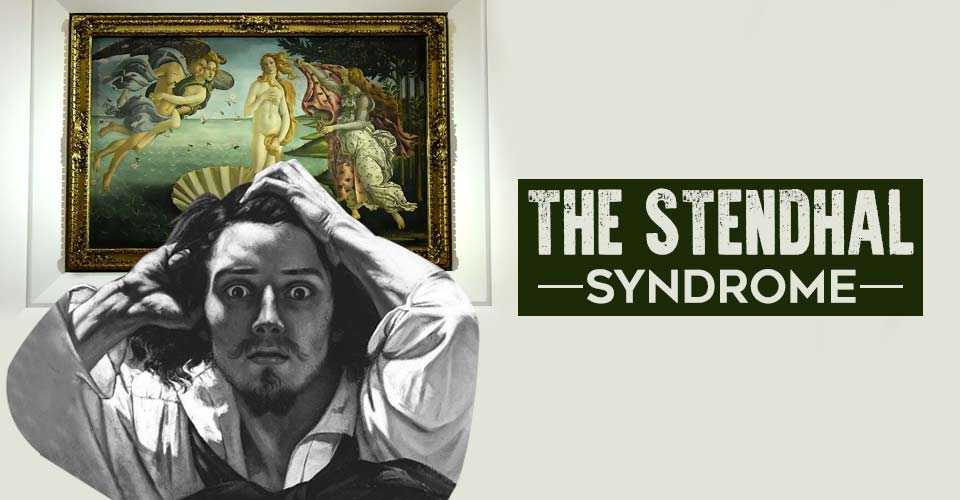Stendhal syndrome (SS) is a rare psychiatric condition caused by exposure to artistic or historical artifacts or after witnessing too many artworks at the same time. It is marked by a state of dizziness, anxiety, or panic.
While syndromes and disorders are both a collection of signs and symptoms occurring over a period of time, a syndrome can be distinguished from a disorder by the fact that symptoms of a disorder are also supposed to be related to each other, while that is not the case with a syndrome. [mfn] Peterson, D., & Keeley, J. W. (2015). Syndrome, Disorder, and Disease. The Encyclopedia of Clinical Psychology, 1–4. https://doi.org/10.1002/9781118625392.wbecp154 [/mfn]
What Is Stendhal Syndrome?
Also known as Florence syndrome or Florentine syndrome, Stendhal syndrome is a psychosomatic syndrome that involves both psychological and physical symptoms, such as hallucinations, doubt, uncertainty, rapid heartbeat, etc. Such symptoms tend to occur in a sufferer when they are exposed to events, experiences, artworks or items of significant aesthetic value, beauty or historical value.
Researchers [mfn] Guerrero, A. L., Barceló Rosselló, A., & Ezpeleta, D. (2010). Síndrome de Stendhal: origen, naturaleza y presentación en un grupo de neurólogos [Stendhal syndrome: origin, characteristics and presentation in a group of neurologists]. Neurologia (Barcelona, Spain), 25(6), 349–356. [/mfn] believe that traveling can often lead to mental discomfort and distress, especially when one is looking for knowledge, self-awareness, and emotions. As a result, several travelers experience psychic discomfort and often seek medical attention.
Alternatively identified as an aesthetic syndrome, it is a clinical phenomenon where “the presence of a beautiful piece of work or architecture causes dysautonomic symptoms such as tachycardia, diaphoresis, chest pains and loss of consciousness,” explains a 2018 study [mfn] Palacios-Sánchez, L., Botero-Meneses, J. S., Pachón, R. P., Hernández, L., Triana-Melo, J., & Ramírez-Rodríguez, S. (2018). Stendhal syndrome: a clinical and historical overview. Arquivos de neuro-psiquiatria, 76(2), 120–123. https://doi.org/10.1590/0004-282X20170189 [/mfn].
However, the Diagnostic and Statistical Manual of Mental Disorders (DSM) does not recognize [mfn] Bamforth I. (2010). Stendhal’s Syndrome. The British Journal of General Practice, 60(581), 945–946. https://doi.org/10.3399/bjgp10X544780 [/mfn] Stendhal syndrome as a psychological condition or disorder.
The condition was named by psychiatrist Graziella Magherini in 1989. She observed that people visiting Florence as tourists tend to experience “acute transient psychiatric symptoms,” [mfn] Nicholson, T. R., Pariante, C., & McLoughlin, D. (2009). Stendhal syndrome: a case of cultural overload. BMJ case reports, 2009, bcr06.2008.0317. https://doi.org/10.1136/bcr.06.2008.0317 [/mfn] such as anxiety attacks, intrusive thoughts, and uncontrollable emotions. This experience was first reported by French author Marie Henri Beyle, whose pen name was Stendhal, when they were visiting the Basilica of Santa Croce in Florence in 1817. [mfn] Stables, D. (2022). Stendhal syndrome: The travel syndrome that causes panic. BBC Travel. Retrieved August 3, 2022, from https://www.bbc.com/travel/article/20220110-stendhal-syndrome-the-travel-syndrome-that-causes-panic [/mfn]
Read More About Emotions Here
Prevalence Of Stendhal Syndrome
Research [mfn] Innocenti, C., Fioravanti, G., Spiti, R., & Faravelli, C. (2014). La sindrome di Stendhal fra psicoanalisi e neuroscienze [The Stendhal syndrome between psychoanalysis and neuroscience]. Rivista di psichiatria, 49(2), 61–66. https://doi.org/10.1708/1461.16139 [/mfn] shows that Stendhal syndrome is more commonly experienced by Europeans rather than Asians, North Americans, or Latin Americans. Many famous personalities have also experienced symptoms associated with Florence syndrome.
For example, the renowned psychoanalyst Sigmund Freud described severe feelings of alienation and depersonalization upon visiting the Acropolis of Athens in Greece. Similarly, the Russian writer Fyodor Dostoevsky reported severe paralysis and absence when he faced Hans Holbein’s Le Christ mort au Tombeau in Basel, Switzerland.
Understanding Stendhal Syndrome
Stendhal’s syndrome is characterized by the concoction of different symptoms when in front of a beautiful piece of art. In simpler words, the condition is triggered in an individual in the presence of exquisite art all placed under a roof, for example, in an art gallery. This mental health condition is considered an unusual psychosomatic illness, also known as Florence Syndrome and hyperkulturemia.
Traveling is believed to be a possible cause of the emotional processes as reported in the clinical cases of Stendhal Syndrome. A person with this condition, when exposed to combined works of art, experiences a wide range of symptoms (physical, mental, and emotional). Such symptoms may include –
- Accelerated heart rate
- Extreme dizziness
- Panic attacks
- Confusion
- Fainting or loss of consciousness
- Disorientation
- Nausea
- Temporary amnesia
- Dissociative episodes
- Paranoia
- Hallucinations
The syndrome is also associated with other circumstances where individuals feel extremely surprised when they are in the presence of what they regard to be of immense beauty. However, these effects stay for a short span of time, and in most cases, do not require medical intervention.
Read More About Paranoia Here
Symptoms Of Stendhal Syndrome

As per a recent study [mfn] Palacios-Sánchez, L., Botero-Meneses, J. S., Pachón, R. P., Hernández, L., Triana-Melo, J., & Ramírez-Rodríguez, S. (2018). Stendhal syndrome: a clinical and historical overview. Arquivos de neuro-psiquiatria, 76(2), 120–123. https://doi.org/10.1590/0004-282X20170189 [/mfn], some of the most common Stendhal syndrome symptoms include:
- Heart palpitations
- Dizziness and fainting
- Hallucinations
- Depersonalization
- Disorientation
- Profound exhaustion
- Chest pains
- Diaphoresis
- Asthenia
- Anxiety
- Tachycardia
- Hot flashes
- Terror
- Sweating
- Emotional tension
- Exhaustion
- Depression
Some sufferers may also become destructive in order to reduce their discomfort and distress, such as destroying a piece of art. The onset of symptoms of Stendhal syndrome is typically sudden and these last for a brief period of two to eight days.
The study mentioned above also revealed the following findings:
- 66% of patients may show neuropsychiatric symptoms
- 29% of patients may exhibit severe mood disorders
- 5% of patients may experience panic attacks and dysautonomia symptoms
Other symptoms of hyperkulturemia or the Florentine syndrome may include:
- Cardiovascular complaints
- Acute myocardial infarction or acute intestinal pain
- Peptic ulcer
- Intense acid reflux and dyspepsia.
- Sexual dysfunctions
However, the condition also causes certain symptoms that may feel pleasing to the sufferer, according to a study [mfn] Palacios-Sánchez, L., Botero-Meneses, J. S., Pachón, R. P., Hernández, L., Triana-Melo, J., & Ramírez-Rodríguez, S. (2018). Stendhal syndrome: a clinical and historical overview. Arquivos de neuro-psiquiatria, 76(2), 120–123. https://doi.org/10.1590/0004-282X20170189 [/mfn], such as:
- Melancholy
- Notable aesthetic pleasure
- Excitement
- Euphoria
These symptoms can be experienced along with anxiety, perceptual disorders, discomforting somatic symptoms, and a deep sense of guilt, leaving the sufferer confused with mixed emotions.
Read More About Anxiety Here
What Causes Stendhal Syndrome?

Research [mfn] Nicholson, T. R., Pariante, C., & McLoughlin, D. (2009). Stendhal syndrome: a case of cultural overload. BMJ case reports, 2009, bcr06.2008.0317. https://doi.org/10.1136/bcr.06.2008.0317 [/mfn] associates the Stendhal syndrome to a few primary factors:
1. Travel
Traveling is believed to be the foremost cause of the emotional disruption reported in clinical Stendhal syndrome cases. For instance, it has been observed that sufferers are typically single, between the ages of 26 and 40 years, and maybe coping with travel exertion [mfn] Bamforth I. (2010). Stendhal’s Syndrome. The British Journal of General Practice, 60(581), 945–946. https://doi.org/10.3399/bjgp10X544780 [/mfn], mobility stress, or jet lag.
Researchers [mfn] Guerrero, A. L., Barceló Rosselló, A., & Ezpeleta, D. (2010). Síndrome de Stendhal: origen, naturaleza y presentación en un grupo de neurólogos [Stendhal syndrome: origin, characteristics and presentation in a group of neurologists]. Neurologia (Barcelona, Spain), 25(6), 349–356. [/mfn] further claim that traveling can often lead to mental discomfort and distress, especially when one is relating travel with:
- Gaining knowledge
- New discoveries
- Spiritual fulfillment
- Emotional richness
As a result, several travelers experience psychic discomfort and often seek medical attention.
2. Culture shock
A 2015 study [mfn] Airault R. (2015). Voyages et risques de décompensations psychiatriques [Risks of psychiatric decompensation in travel]. La Revue du praticien, 65(4), 509–512. [/mfn] stated that “any trip is a source of stress that may trigger or worsen mental disorders ranging from culture shock to a pathogenic trip via the classic pathological trip.” Therefore, any travel-related illness may be caused due to the major impact traveler experiences with the change coming from a different culture and way of life than their own.
Consequently, these travel-related illnesses are observed in almost every culture and destination where the traveler may falter and experience discomfort and emotional changes at some stage of the journey.
3. The link between art and emotion
From the clinical point of view, Stendhal syndrome is a polymorphic condition and, therefore, it must be addressed in an individual manner. This syndrome generally develops in tourists who are fond of art and admire its beauty.
The condition generally arises when they are present in places that take their breath away or for some reason have a very strong emotional meaning to them. It is the development of a connection between emotion and knowledge in the deepest spaces of the mind.
When a traveler observes some exquisite works of art, a displacement and detachment from their usual environment arise which defines the onset of symptoms followed by the eventual treatment.
The syndrome is also associated with other circumstances where individuals feel extremely surprised when they are in the presence of what they regard to be of immense beauty.
However, these effects stay for a short span of time and, in most cases, do not require medical intervention.
Some researchers say that the syndrome is triggered when people observe works of great beauty in a short period of time. In such a narrow timeframe, the afflicted persons are astonished by the beauty and they find it difficult to cognitively process the meaningfulness and depth of such art.
In other cases, a critical physiological response [mfn] Teive, H. A., Munhoz, R. P., & Cardoso, F. (2014). Proust, neurology and Stendhal’s syndrome. European neurology, 71(5-6), 296–298. https://doi.org/10.1159/000357562 [/mfn] is produced, closely resembling syncope or sexual climax. Resultantly, they are forced to remove themselves from the experience since they lack the ability to tolerate such an intense connection with art.
Thus, Stendhal syndrome is kind of an artistic shock. It is noteworthy that aesthetic syndromes are caused not only by manmade works of art but also by nature.
4. Health conditions
Studies [mfn] Arias M. (2019). Neurology of ecstatic religious and similar experiences: Ecstatic, orgasmic, and musicogenic seizures. Stendhal syndrome and autoscopic phenomena. Neurología del éxtasis y fenómenos aledaños: epilepsia extática, orgásmica y musicogénica. Síndrome de Stendhal. Fenómenos autoscópicos. Neurologia (Barcelona, Spain), 34(1), 55–61. https://doi.org/10.1016/j.nrl.2016.04.010 [/mfn] also contend that the presence of mental health disorders and other comorbid health conditions can also make people vulnerable to the Stendhal syndrome effects. Research [mfn] Guerrero, A. L., Barceló Rosselló, A., & Ezpeleta, D. (2010). Síndrome de Stendhal: origen, naturaleza y presentación en un grupo de neurólogos [Stendhal syndrome: origin, characteristics and presentation in a group of neurologists]. Neurologia (Barcelona, Spain), 25(6), 349–356. [/mfn] shows that people who develop the syndrome are negatively triggered by the landmark stages in their journey.
For instance, it was seen that the end of a journey can develop an intense sense of sadness and depression in a traveler.
This generally occurs when the traveler’s hometown contains less gorgeous works of art when compared to the city that he/she has visited. It produces the onset of very distressing symptoms.
Read More About Major Depressive Disorder (Depression) Here
Risk Factors For Stendhal Syndrome
Stendhal syndrome depends on certain risk factors, such as:
- Marital status
- Educational level
- Age
- Reaction to stress
- Financial resources
- Living alone
- Religious upbringing
- Journey goals
Thus, it is suggested that travelers must take enough rest to calm their minds before heading out for another trip, must be well-fed, hydrated, and should use some sort of sun protection.
Read More About Aging Here
How To Treat Stendhal Syndrome?
There is no specific cure for aesthetic syndromes as they are a psychosomatic response to culture. Moreover, Stendhal syndrome is not officially regarded as a clinical diagnosis.
However, certain treatment approaches can help to address and relieve the symptoms and associated conditions in fleeting disorders like Stendhal syndrome. Medication, along with relaxation techniques (like deep breathing) can help to manage physiological and psychological symptoms in the sufferer.
The treatment for Stendhal syndrome is mainly focused on its associated effects, such as preventing major injuries followed by a syncopal activity or eliminating major associated complications along with important differential diagnoses.
As per research [mfn] Arias M. (2019). Neurology of ecstatic religious and similar experiences: Ecstatic, orgasmic, and musicogenic seizures. Stendhal syndrome and autoscopic phenomena. Neurología del éxtasis y fenómenos aledaños: epilepsia extática, orgásmica y musicogénica. Síndrome de Stendhal. Fenómenos autoscópicos. Neurologia (Barcelona, Spain), 34(1), 55–61. https://doi.org/10.1016/j.nrl.2016.04.010 [/mfn], the processes in Stendhal syndrome treatment aim to assess the health of the brain during recovery.
This includes examining the brain regions associated with consciousness, social interaction, processing of emotion, and memory and checking for pathological and comorbid conditions.
Prognosis Of Stendhal Syndrome
Stendhal syndrome is a controversial and unusual disorder with a non-uniform pattern. The symptoms of this condition can affect anybody. It is normal for individuals to feel dizzy, exhausted, or even experience an increased heartbeat at any moment. Furthermore, the symptoms do not always show up when one encounters a great work of art.
Research [mfn] Fried R. I. (1988). The Stendhal syndrome. Hyperkulturemia. Ohio medicine : journal of the Ohio State Medical Association, 84(7), 519–520. [/mfn] and clinical practice hasn’t yet found a cure for it, claiming that if a person is inflicted by the syndrome, chances are high that they will experience the symptoms several times throughout their life on observing other works of art elsewhere.
Takeaway
Stendhal syndrome is a rare psychiatric condition that occurs in bouts and can last for a lifetime. During its episodes, it disables its sufferers from carrying out even the simplest of tasks. However, it can be easily managed through therapy, medications, and relaxation techniques.
Stendhal Syndrome At A Glance
- Stendhal syndrome (SS) is a rare psychiatric condition caused by exposure to art and aesthetics.
- It is a brief mental condition lasting for 2–8 days.
- It is caused by a number of factors like travel, culture shock, perception of art, mental health disorders, etc.
- The typical Stendhal syndrome symptoms include dizziness, increased heartbeat, depression, chest pains, sweating, hallucinations, etc.
- The syndrome goes away on its own. In chronic cases, it is treated by therapy and medication.
Frequently Asked Questions (FAQs)
1. Is Stendhal syndrome a mental illness?
There is no scientific basis for categorizing Stendhal syndrome as a mental illness since it lacks sufficient research. Nonetheless, some brain regions are involved when exposure to art triggers disturbed emotional responses.
2. How long does Stendhal syndrome last?
Stendhal syndrome usually lasts for a brief period of time, typically 8–10 days since its onset.
3. Is Stendhal syndrome real?
There is substantial evidence that Stendhal syndrome is real, but it is not unique to Florence. Such strange “aesthetic sickness”—like India syndrome and Paris syndrome— is often a “cultural shock” and emotional distress experienced by people traveling to foreign countries.










Leave a Reply